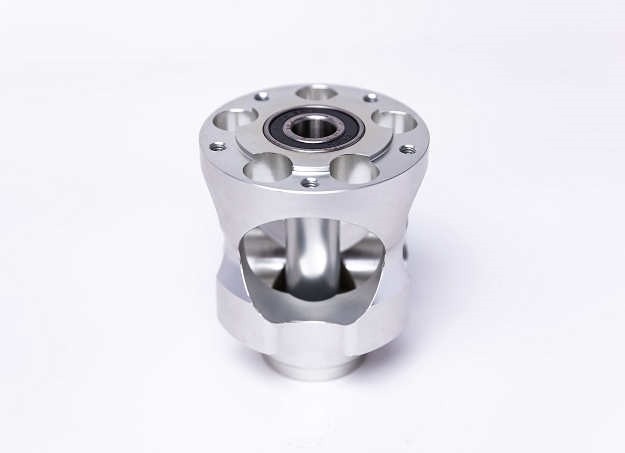CNC (Computer Numerical Control) machining is an automated manufacturing process that uses computer-controlled tools to produce precise components. Among the most widely used types of CNC machining are CNC milling and CNC turning. Both processes are crucial for producing high-precision parts, but they differ in how they work and the types of parts they create.

What is CNC Milling?
CNC milling involves rotating cutting tools that remove material from a stationary workpiece. The cutting tool moves along multiple axes (typically 3 to 5) to shape the part, using tools like end mills, face mills, and drills. Milling machines can be either vertical or horizontal.
Common CNC Milling Operations:
- Face Milling: Removes material from the flat surface of a workpiece.
- End Milling: Cuts along the sides, ideal for complex shapes.
- Slotting: Cuts narrow grooves or slots.
- Drilling: Creates holes in the workpiece.
- Tapping: Produces internal threads.
Components of a CNC Milling Machine:
- CNC Controller: Interprets the program and controls tool movements.
- Spindle: Holds and rotates the cutting tool.
- Worktable: Secures the workpiece, moving it in different directions.
- Cutting Tools: Includes various tools for specific machining tasks.
Applications of CNC Milling: CNC milling is ideal for creating parts with intricate 3D geometries such as engine components, molds, and custom enclosures used in industries like aerospace, automotive, and electronics.
What is CNC Turning?
CNC turning, in contrast, involves rotating the workpiece while a stationary cutting tool shapes the part. The workpiece is mounted on a lathe, and the tool moves along its surface to remove material, typically forming cylindrical parts such as shafts, pins, and bushings.
Common CNC Turning Operations:
- Facing: Flattens the end of a workpiece.
- OD Turning: Shapes the outer diameter of the workpiece.
- Boring: Enlarges or finishes internal diameters.
- Threading: Creates internal or external threads.
- Grooving: Cuts narrow channels along the workpiece’s length.
Components of a CNC Turning Machine:
- Lathe Machine: Holds and rotates the workpiece.
- Cutting Tools: Mounted on a tool holder and fed into the rotating workpiece.
- Workpiece: Typically cylindrical and mounted on the lathe spindle.
Applications of CNC Turning: CNC turning is best suited for creating rotationally symmetric parts and is used extensively in industries like automotive, aerospace, and medical device manufacturing for parts like gears, pins, and engine components.
CNC Milling vs. CNC Turning: Key Differences
| Aspect | CNC Milling | CNC Turning |
| Workpiece Movement | Stationary, tool moves | Workpiece rotates, tool moves linearly |
| Best for Shapes | Complex 3D parts, prismatic components | Cylindrical, conical parts |
| Tool Movement | Tool moves along multiple axes (3-5 axes) | Tool moves along 1-2 axes |
| Applications | Detailed features, pockets, holes, and grooves | Rotationally symmetric parts like shafts |
| Precision | ±0.001 in (0.025 mm) | ±0.0005 in (0.0127 mm) |
| Production Speed | Slower for complex parts | Faster for cylindrical parts |
Key Differences at a Glance
- Machining Process: CNC milling uses rotating cutting tools while CNC turning rotates the workpiece with a stationary tool.
- Primary Use: CNC milling is best for complex, multi-surface parts, while CNC turning excels at creating cylindrical and round parts.
- Speed and Efficiency: Turning generally offers faster production for cylindrical parts, while milling is more suited for detailed, multi-surface machining.
- Tool Movement: Milling involves multi-axis tool movement, whereas turning typically operates along 1-2 axes.
Advantages and Applications
CNC Milling
Advantages:
- Versatility: Can handle various materials and create complex geometries.
- Precision: Ideal for intricate details and non-rotational shapes.
- Multi-Operation: Capable of performing multiple operations (e.g., drilling, milling) in one setup.
Applications:
- Aerospace: Engine components, turbine blades.
- Automotive: Transmission cases, engine blocks.
- Medical: Surgical instruments, implants.
CNC Turning
Advantages:
- Efficiency for Rotational Parts: Perfect for high-speed production of cylindrical parts.
- Simpler Setup: Easy to perform multiple operations after mounting the workpiece.
- Cost-Effective for Mass Production: Ideal for creating simple, rotationally symmetric parts in bulk.
Applications:
- Automotive: Shafts, gears, and bushings.
- Aerospace: Engine parts, structural components.
- Medical: Implants, prosthetics.
Choosing Between CNC Milling and CNC Turning
Choose CNC Milling if:
- You need complex 3D shapes or parts with non-rotational symmetry (e.g., aerospace brackets).
- Your design has multiple flat surfaces, pockets, or slots.
- Multi-axis machining is required for intricate details.
Choose CNC Turning if:
- The part is cylindrical or rotationally symmetric (e.g., shafts, nuts, pulleys).
- You require high-speed production of simple round components.
- Your design includes threads or grooves.
Combined Approach (Turn-Mill Centers): Some advanced CNC machines combine both milling and turning, allowing for more complex parts (e.g., camshafts with milled keyways).
Conclusion
CNC Milling is best for creating complex, multi-surface parts, while CNC Turning is ideal for producing fast, precision cylindrical parts. Both processes offer unique advantages depending on the part’s geometry and production requirements. Understanding when to use each process—and, in some cases, combining both techniques—ensures high efficiency and precision in modern manufacturing.

